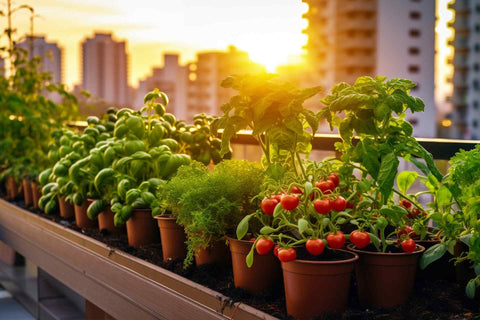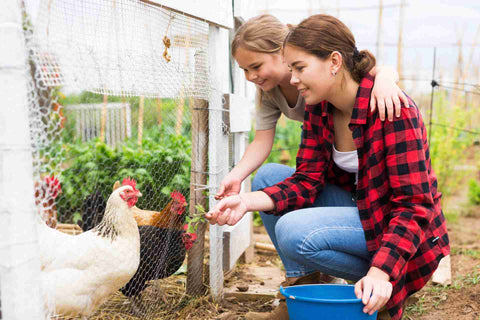Homestead plan in an urban setting is a term that can refer to various things.
It can refer to programs by the government to help people settle into homes in the city.
On the other hand, a homestead plan can also mean the practice of sustainable agricultural techniques.
Through the years, there has been a steady increase in urban homesteaders due to the conscious desire of the people to live in an eco-friendly environment.
Homestead plan in the city encompasses a wide range of ideas.
It includes reducing power consumption through the use of alternative resources. Aside from relying on big companies to power their homes, some homesteaders use solar power and windmills to produce electricity. They also harvest clean drinking water from the rain.
Homesteading also includes alternative means of transportation, such as bicycles and buses. Some houses also produce biogas from organic materials to power their automobiles.
On the other hand, some would raise poultry animals, do edible landscaping, and practice self-sufficient living. They produce food for the family or the neighbors when there's a surplus. These aspects of the city's homestead plan make modern families save monetary resources and promote healthy living.
An urban homestead is a revolutionary plan for simple and sustainable living.
In this article, we'll tackle how to start the urban homestead setting and its benefits to the family.
History of Urban Homestead Plan

Homesteading concepts and the maintenance of a garden are universal. It has been expected since Roman times.
According to From Scratch Magazine, a small homestead was a norm, and commercial farming did not exist during this period.
During World War I and II, victory gardens, immigrant gardens, and inner-city community gardening began. Families worldwide have found ways to grow food in the inner city of the urban areas, even in limited space.
In the new millennium, towards the 1990s, the principles of self-reliance were incorporated into urban environments. According to From Scratch Magazine, John Seymour was one of the influential people to emphasize small-scale farming in homesteading.
Benefits of Urban Homesteading
Building a self-sufficient lifestyle in the city brings various benefits.
Here are some of it:
Socio-Economic Benefits
Building an urban homestead in the community can bring families and communities together by working towards one goal that benefits everybody.
In addition, it creates more productive and better living conditions for the current and future generations.
Aside from this, building urban homesteads can empower people because they'll have the freedom and security to produce their food. They will be more active in participating in food production and food preservation.
Furthermore, it teaches people how to be self-sufficient and practical to think of ways to combat hunger.
Waste materials are being transformed into compost, and free spaces in the cities are being utilized to produce farms.
Lastly, it can create more jobs and income for the family. It can make a productive local economy that does not need to import food supplies from far away places.
Environmental benefits
Building gardens in the urban space can make the city green. It can help clean the water by using the rain and building filters to purify it.
Urban homesteading also teaches people to save water consumption by recycling it for cleaning the house and watering the plants. It can also clean the air by planting vegetables, fruits, and trees to produce oxygen and absorb carbon dioxide.
Urban homesteading can also stop soil erosion and the removal of the topsoil.
The biodegradable waste materials inside our homes can be converted into compost, creating fertilizers for our plants. It can decrease carbon footprint by using alternative modes of transportation.
There is also minimal power consumption through energy-efficient appliances inside the house. It can increase the amount of food grown locally.
A healthy diet will be promoted for people of all ages. Food poisoning, obesity, and other diseases will be prevented by eating the right kind of food.
According to research, a healthy gut will create a good body, and this can start by eating food produced in your backyard.
Planning an Urban Homestead

Planning thoroughly is the first step in creating an effective and long-lasting urban homestead.
The following are essential things to bear in mind:
1. Examine your area
It is essential to assess the available land before starting the process of creating your urban homestead:
- Measure the size of your home and any outdoor areas, such as patios, decks, and roofs. If the land or area is too crowded, it will hurt the animals' health and the plants' growth.
- Choose a location with lots of water and sunlight. Pick a spot with easy access to water and get at least six hours of sunlight each day.
- You should check your area's zoning laws and regulations to ensure starting a farm or garden is allowed before you start. Urban homesteading may require special rights or licensing from some municipalities.
2. Pick suitable plants and animals.
Consider the available space and the environment around you to learn what kind of plants and animals can survive there:
- The best crops for urban homesteading include tomatoes, peppers, lettuce, herbs, and berries.
- Try vertical gardening with fences or hanging plants if your space is limited.
- Before introducing any animals into your home, consider what species will thrive in the environment of your urban homestead.
- Urban homesteaders frequently choose chickens because they can easily offer eggs and meat while occupying little space.
- You may even raise goats, quail, rabbits, or even bees to produce honey, depending on the regulations in your area.
Combining several plant species is one method to make the most of your space while nurturing the growth of your plants. As an illustration of companion gardening, consider growing tomatoes and basil next to the crops to ward off pests.
3. Make a layout plan.
Start by sketching a floor layout of your house, including any outside elements like balconies, roofs, and backyards:
- Consider how the exposure to sunlight, water, and wind in your area may affect the design of your home.
- Calculate the amount of space required for each plant species you intend to grow before designing the layout of your garden.
- Use raised beds or vertical gardening to grow more plants in a smaller space.
- Consider building a compost pile as another option to eliminate your organic waste. Doing this might support recycling efforts while providing your plants with essential nutrients.
- Build cages appropriate for the size and needs of the animals you plan to maintain on your urban homestead. Chickens require a coop and a run, whereas bees require a hive.
- Construct a pathway connecting different urban homestead areas for simple access.
4. Set your budget.
Setting goals and making decisions about your urban homestead's expenses are more manageable when you have a budget:
- Make a list of everything you'll need to start your urban farm, including garden beds, soil, plants, seeds, animal cages, and equipment.
- Check around for the highest price on everything on your list.
- Remember to account for the shipping and handling fees when making online purchases.
Ways to Start Urban Homesteading
The benefits mentioned above are just a part of the bigger effects of homesteading in the community.
This portion will discuss ways to start living in an urban homestead setting. It takes proper planning and preparation to live a self-sufficient life.
Moreover, it is a continuous process; lifestyle changes do not happen overnight. Here are some of it:

Food
Food production in urban homesteading starts with the conversion of the soil. One can try mulching, composting, vermiculture, re-mineralization, animal manure, and effective micro-organisms.
When the soil is ready, plant fruits and vegetables in your garden.
Harvest your produce and learn how to preserve it for future purposes. You can start canning, drying, freezing, fermenting, and brewing.
Perishable goods have a short shelf life, but if it's processed accordingly, it can stay for a longer period. Some produce of urban homesteaders is being sold in local markets. These products are organic and affordable; thus, it is becoming popular nowadays.
Waste
In urban homesteading, reducing, reusing, and recycling are essential. The idea is to minimize waste products in a day. Small things matter in urban homesteading.
To do this, learn to use second-hand items or give life to the old stuff you have at home. You can repaint old shelves, chairs, and furniture instead of buying new ones.
In addition, you can also think outside the box and give a stylistic design to your old clothes to avoid repurchasing new garments. Use paper bags instead of plastic when shopping for groceries.
Also, recycle water bottles and turn them into something useful. Meanwhile, convert your biodegradable wastes to compost. Combine the leaves, vegetable and fruit peelings, and old newspapers, and top it with soil.
The compost will create a healthy fertilizer for your plants. Make sure to water your compost occasionally to help decompose the materials.
Water
Water is essential inside our home. We use it to clean our house, water the plants, and nourish the body.
There are many ways to create a self-sufficient water system in an urban homestead plan. The first one is to build a water well. This can be done by digging a hole in the ground, installing pipes, and pumping water above.
Permits must be secured in the local offices to install a water well. The next option is the installation of a rainwater collector. This system will collect rainwater and convert it to safe water using filters.
Rainwater can water plants, clean the house, and cook. Water irrigation, greywater, and mulching are some of the most effective systems you can try for gardening.
For efficient water consumption in your urban homestead, you can wash the dishes by hand and avoid doing it in running water. You can also have an outdoor shower so the garden can utilize the water you've used to clean your body.
Alternative Energy
Besides producing food, urban homesteading teaches people to live with minimal energy consumption and find alternative resources.
Some of the alternative sources are solar panels and windmills.
Solar technology has been used since the 1950s for industrial purposes. This technology works by harnessing the sun and turning it into electricity. It requires using solar panels that we sometimes see in the fields or rooftops. When the sun shines on the panels, the cells absorb photons, creating an electric field that allows electricity to flow.
Meanwhile, wind turbines collect the wind and transform it into electricity. Professionals at your home can set up this technology.
On average, wind turbines measure about 80 feet, generating a 5-kilowatt capacity to support energy requirements at home. It costs around $10,000 to $70,000, depending on the installation expenses.
Apart from these alternative resources, urban homesteading also requires wise energy use. This includes low-voltage and highly efficient appliances, rechargeable batteries, LED lights, and manual hand tools.
Doing household chores manually without relying heavily on electricity is also recommended. This includes washing and drying clothes under the sun's heat, cleaning the room manually without a vacuum, and preparing food with kitchen tools without electricity.
Finally, the house must also be set up according to the weather conditions of the place. It must have a high ceiling and big windows to allow air circulation, especially during summer. It must have a fireplace to warm the family, especially during cold nights.
Transportation
Modes of transportation in urban homesteading must be eco-friendly, too. Walking, jogging, or using a bike is advisable in short-distance places. In long distances, one can use buses or trains instead of private automobiles because this can minimize your carbon footprint.
Carpooling is the newest trend today besides using buses and trains. This is sharing a private automobile with strangers to the same destination. Carpooling can reduce fuel costs and help create a better environment.
Meanwhile, UrbanHomestead.org created their biogas to fuel their automobiles. It involves brewing biodegradable wastes and turning them into diesel. This is also a great source of diesel because it uses organic matter, is eco-friendly, and is self-sufficient.
Animals
Apart from fruits and vegetables, you can also raise your poultry in an urban homestead setting.
All creatures, great or small, are part of the natural cycle, even the farm animals. You can also raise chickens, goats, rabbits, and ducks in the city. To do this, fence your lot first to ensure the farm animals will never wander on your neighbor. Then, build a pen for your farm animals.
Make sure that it is ventilated, and it is dry. Provide your animals with enough food and clean their surroundings regularly.
You can also convert into fertilizer their waste materials. You can eat your farm animals or sell the eggs and the meat at the local market. Some homesteaders are strict vegetarians and wouldn't want to eat meat; thus, they trade their produce to their neighbors.
Living Simply
Lastly, living simply is the key to a thriving urban homesteading plan.
Our forefathers have survived to live self-sufficient and straightforwardly for many years, and you can do that!
To do this, learn a few things by yourself at home. Learn how to make your meals to prevent eating at expensive restaurants. Study how to cook delicious meals and bake pastries for the family.
Next, bring entertainment inside your home. Start reading books, painting, or doing crafts. You can also learn about animal husbandry, marcotting plants, or flower arranging. This knowledge will not only be entertaining, but in the long run, this could be a source of passive income for you.
Instead of traveling to faraway places, consider bringing your friends inside the house. Do home socialization and family reunions instead.
Do the household chores manually. Repair the things on your own, cut your hair, repair the bike, sew your old clothes, fix the leaks on the roof, and do your laundry.
Orienting yourself to herbal medicine and the basics of emergency preparedness and survival is also helpful. Open a store, allowing the community to barter goods with each other. Trade your excess food produced with things that you need inside your home.
Tips On Growing Food
Growing your own food on your urban farm is essential to be self-reliant. In addition to giving you access to healthy, locally-grown vegetables, it could help you save money on groceries. Here are some tips for growing a fruitful garden in an urban setting:

► Prepping Your Soil
Check the pH and nutrient levels of the soil before planting anything. You may purchase a soil test kit at your local gardening store or send a sample to a lab for a more thorough analysis.
Testing the PH and nutrient levels of the soil would reveal the type of treatments required. After knowing what needs improvement, you can add organic material, such as compost, manure, or other soil amendments.
Incorporating organic matter may improve soil fertility, drainage, and structure.
Ensure that the topsoil is evenly covered with the amendments. If you don't have a large space, consider raised beds and container gardening.
While container gardening allows you to grow plants in a much smaller space, raised beds let you control the moisture and drainage of your soil.
► Choosing the Suitable Plants
The weather and the type of soil you have must be considered while choosing what plants to grow. For optimum results, pick plants suited to your soil and environment.
Choose a simple species if you're just starting in gardening. Among the simplest to grow are beans, lettuce, tomatoes, and herbs.
Trellises and vertical gardens are excellent solutions for people with little outdoor space.
Planting in pots is a fantastic alternative for individuals constrained by a lack of outdoor space.
Grow the foods you like to consume the most as well. If you concentrate on growing the things you enjoy eating and applying in your cooking, gardening will be more enjoyable.
► Maintaining Your Garden
Maintaining your urban homestead garden is essential to ensuring healthy plant growth and an excellent harvest.
Regular watering is crucial for the growth and health of your plants. Be careful not to overwater your plants because doing so can lead to root rot.
Although viruses and insects can ruin your garden, there are more natural ways to deal with them. Companion planting, neem oil, and insecticidal soap can all be used to control pests and diseases.
Weeds deprive your plants of water and nutrients, so keep them out of your garden. Regular weeding will also help to reduce the spread of disease and pests.
Tips On Raising Livestock
Raising animals is also a part of urban homesteading. Here are some things to consider if you're planning to start a small farm:

► Choose Suitable Livestock/Animal
Urban homesteaders typically focus more on raising chickens than any other animal. They require minimal maintenance and provide meat, eggs, and even serve as fertilizer. They are helpful as a food source and a suitable pest management method.
Bees are another popular choice for urban homesteaders. Bees can live in tiny spaces, such as a rooftop or a balcony, and are helpful because they can make honey and pollinate plants.
Although they don't require much maintenance, you'll need specialized tools and knowledge to care for them.
Rabbits are an excellent option if you're an urban homesteader seeking ways to grow your own meat. Despite being plain and simple, they require constant care to survive.
Goats are a fantastic alternative for urban homesteaders with more space who want to grow animals for milk, cheese, or meat production.
Urban residents are increasingly choosing miniature pigs as a feasible livestock choice. Due to their smaller size when compared to regular pigs, they require less space. Although they are lovely and cheerful, they require constant maintenance.
► Basic Requirements for Care and Feeding
Livestock raised in urban areas may require varied housing and food requirements depending on the species.
All animals should have enough fresh water and food suitable for their species. To ensure that your animals thrive, make sure there is always access to clean water.
Sheltering animals is crucial because it protects them from the elements and enables them to live in stability. Depending on the species, a coop, hutch, or a stable may be needed.
A vast space is not required for animals like chickens and rabbits, but goats need a larger area. Remember to leave adequate space for your animals to move around in.
Your animals need ongoing care and regular vet visits to stay healthy. Preventing parasites, receiving vaccinations, and grooming are a few instances.
Keep your animals away from potential threats like predators to ensure their protection. In addition to bringing them inside at night or taking other safety precautions, fencing or netting might be required.
► Follow Regulations Accordingly
Verify the zoning regulations and limits to ensure you can have livestock on your property. There can be restrictions on the types and quantity of animals you can keep in your area.
Depending on where you live, you might require a license or permission to keep animals. Ask the appropriate authorities in your area what regulations are in place.
You are required to abide by all local and state regulations about animal welfare. This could refer to requirements such as a secure place to reside, enough food and water, and accessibility to a veterinarian.
Sometimes, having animals in an urban environment may cause neighbors to complain about the noise or stench. Be careful to keep these inconveniences to a minimum out of respect for your neighbors.
Your liability exposure rises if your cattle causes someone else's property damage or injuries. Get complete insurance coverage for you and your belongings.
Conclusion

In sum, urban homesteading is an old concept gaining popularity today. It can enhance your quality of life and benefit the environment. You can save money and lessen your environmental effects by growing your food, raising your animals, and making other sustainable lifestyle decisions.
Anyone can build an urban homestead on their balcony or yard with planning, effort, and commitment to sustainable living.
Urban homesteading is a process that will take several years to see the effects. However, every step is worth it since you change for the best.




Leave a comment
All comments are moderated before being published.
This site is protected by reCAPTCHA and the Google Privacy Policy and Terms of Service apply.